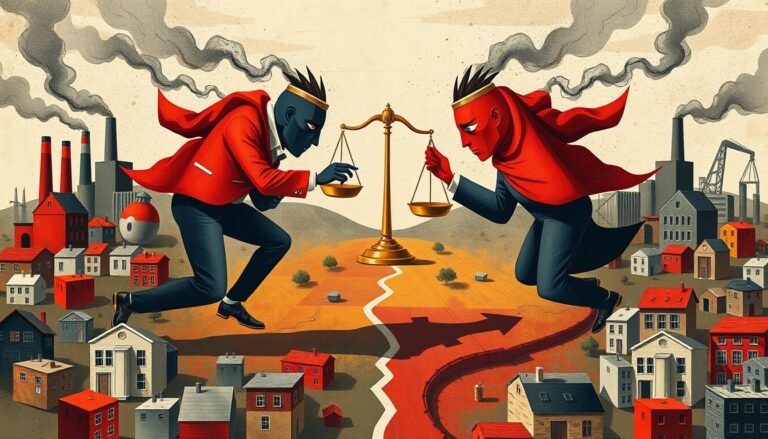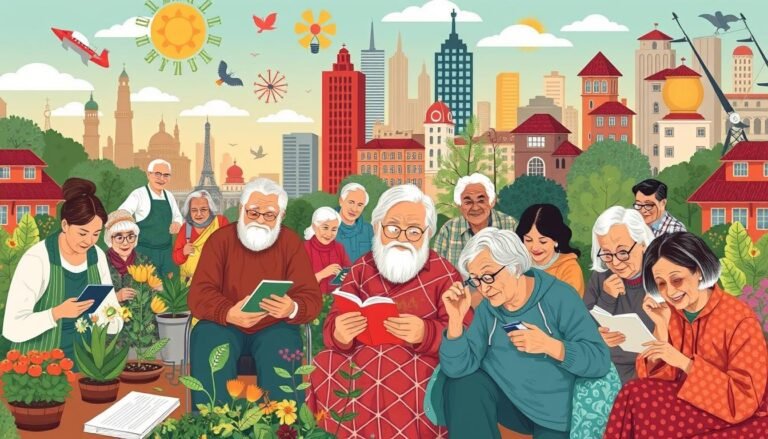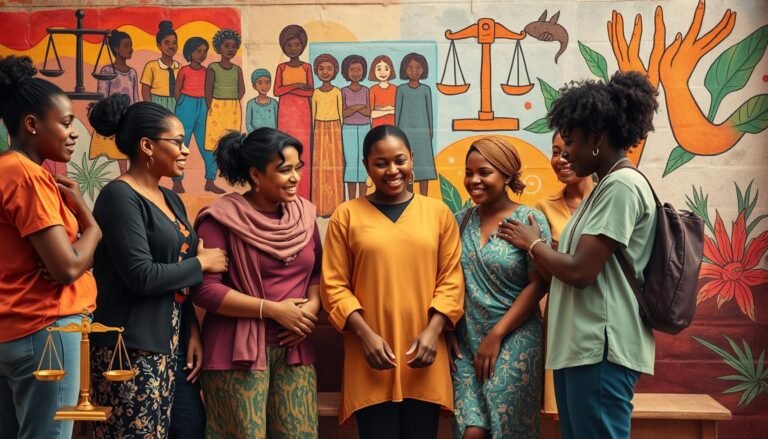Social Constructionism: How Reality is Shaped by Society
Have you ever thought about why some actions are okay in one place but not in another? This is what social constructionism is all about. It’s a theory that shows how society shapes what we think is real.
Social constructionism says we make our view of the world by talking and understanding things together. Peter L. Berger and Thomas Luckmann talked about this in their 1966 book “The Social Construction of Reality.” They showed that what we think is real is really shaped by how different cultures see things.
In our everyday lives, we keep making and strengthening these social ideas. These ideas help build our societies and shape our beliefs and norms. Knowing about this can help us see how our views of the world are shaped. It can also make us question things we’ve always taken for granted.
Key Takeaways
- Social constructionism explains how society shapes our understanding of reality
- Shared meanings and cultural relativism play crucial roles in this theory
- Berger and Luckmann introduced the concept in their 1966 book
- Our perceptions of “normal” and “taboo” are influenced by social constructs
- Recognizing social constructs can help us challenge assumptions and broaden our perspectives
Understanding the Foundations of Social Constructionism
Social constructionism looks at how society shapes what we see as real. It’s based on sociology and communication theory. It says that much of what we think is real comes from how we talk and share meanings with others.
Origins and Key Thinkers
About thirty years ago, social constructionism started. It was influenced by thinkers like Max Scheler, Edmund Husserl, and Alfred Schutz. A big step forward was Berger and Luckmann’s 1966 book “The Social Construction of Reality”.
Core Principles of Social Constructionism
Social constructionism believes reality is not set in stone. It changes with cultures and societies. It also questions the idea of fixed personalities and identities. Instead, it says these are shaped by the world around us.
| Traditional View | Social Constructionist View |
|---|---|
| Fixed personality traits | Identity shaped by social interaction |
| Objective reality | Reality as socially constructed |
| Universal truths | Cultural and societal variations |
The Role of Language and Symbols
Language is key in social constructionism. It helps us make and share meanings. This way, we can understand different parts of reality. Symbolic interactionism also looks at how symbols and gestures help build our social identity through talking and daily life.
Learning about these ideas helps us see how our view of reality comes from the society we’re in. It affects our identities, social norms, and institutions.
The Social Construction of Reality: Berger and Luckmann’s Perspective
In 1966, Peter Berger and Thomas Luckmann published “The Social Construction of Reality.” This book changed sociology forever. Their ideas on how society shapes our view of the world are still important today.
Berger and Luckmann talked about the social stock of knowledge. This is the shared customs, meanings, and routines we all know. It spreads through society, affecting how we see and interact with things.
They also talked about intersubjectivity. This means we live in many realities, based on our social surroundings. Our everyday life is filled with the shared meanings we’ve made with others.
| Concept | Description | Impact |
|---|---|---|
| Social Stock of Knowledge | Shared customs and interpretations | Shapes collective understanding |
| Intersubjectivity | Coexistence of multiple realities | Influences daily experiences |
| Institutionalization | Established social processes | Reduces uncertainty |
Today, Berger and Luckmann’s work is still big in sociology. A survey of 500 sociologists showed that 68% use their theories in research and teaching. Their ideas have been mentioned in over 14,000 academic papers, proving they’re still important.
“If men define situations as real, they are real in their consequences.” – W.I. Thomas
This quote, known as the Thomas theorem, fits with Berger and Luckmann’s views. It shows how our own views can change reality. This supports the idea that our social world is made by us.
Habitualization and Institutionalization in Society
Society shapes our daily lives with repeated actions and shared beliefs. This process, called habitualization, lays the groundwork for our social world. As these patterns stick, they turn into structures that guide our actions and shape social norms.
The Process of Habitualization
Habitualization happens when we keep doing actions, making patterns. This makes things less uncertain and helps us make decisions faster. In 1966, sociologists Peter Berger and Thomas Luckmann talked about this. They said actions that become habits can be done efficiently.
From Personal Habits to Social Institutions
When personal habits spread in groups, they become the start of social institutions. This change means actions are recognized and repeated by everyone. Over time, these shared habits grow into a big institutional order, shaping our social world.
The Impact of Institutionalization on Social Norms
Institutionalization deeply affects social norms. It sets up a division of labor, controls actions, and shapes how we interact. The structure of institutions changes how we talk, work, and show our sexuality. These norms become so deep that they seem like the real truth.
| Aspect | Impact on Social Norms |
|---|---|
| Communication | Shapes language use and interaction patterns |
| Labor | Defines job roles and work expectations |
| Sexuality | Influences relationship norms and gender roles |
| Territoriality | Establishes boundaries and spatial behaviors |
Understanding these processes shows us how our social reality is built and kept up. It also points out chances for social change by questioning norms and institutions.
Social Constructionism: How Reality is Shaped by Society
Social constructionism looks at how society shapes our everyday reality. It says our view of the world changes over time through social interactions. Our shared experiences help create common understandings.
Intersubjectivity is key in social constructionism. It means the shared meanings we make with others. These meanings shape our social reality and how we see the world.
Reflexivity is also important. It’s about thinking about our thoughts, actions, and the groups we belong to. Through this, we can question and maybe change our social reality.
| Concept | Definition | Impact on Social Reality |
|---|---|---|
| Intersubjectivity | Shared meanings created through social interaction | Forms the basis of common understanding |
| Reflexivity | Ability to reflect on one’s thoughts and actions | Allows questioning and reshaping of social structures |
| Social Everyday Reality | Collective understanding of daily life | Shapes individual perceptions and behaviors |
Social constructionism says our reality isn’t fixed by biology alone. It highlights how social interactions, language, and culture shape our views and beliefs.
The Role of Symbolic Interactionism in Constructing Reality
Symbolic interactionism is key to understanding reality. It looks at how we use and understand symbols in social settings. It shows that symbols don’t have fixed meanings but are made in our daily interactions.
Symbols and Their Meanings in Social Interaction
In this view, language, gestures, and objects are symbols with cultural meanings. They help us communicate and understand our world. For instance, a handshake might mean friendship in one culture but not in another.
Interpretation of Gestures and Language Across Cultures
How we see gestures and language changes with culture, showing that meaning is made by us. What’s polite in one place might be seen as rude elsewhere. This shows how our reality changes based on where we are and who we’re with.
The Impact of Symbolic Interaction on Identity Formation
Symbolic interactions help shape who we are. As we interact, we interpret and respond to symbols, which shapes our identity and roles in society. This ongoing process helps build our social reality.
Herbert Blumer, a major figure in symbolic interactionism, said our actions are based on the meanings things have for us. These meanings come from social interaction and change as we interpret them. This view helps us see how our reality is always being shaped by our interactions with others.
The Thomas Theorem and Self-Fulfilling Prophecies
In 1928, W.I. Thomas introduced the Thomas theorem. It says our actions come from how we see the world. This idea helps us grasp self-fulfilling prophecies and how our expectations shape our reality.
Self-fulfilling prophecies happen when our beliefs guide our actions, making those beliefs come true. This is key in shaping our social world and personal lives.
Social expectations deeply affect many parts of life. For instance, what teachers expect from students can change how well they do:
- High teacher expectations often lead to better student performance
- Low teacher expectations can result in poorer student outcomes
- Racial and socioeconomic biases can influence teacher expectations
Self-fulfilling prophecies aren’t just in education. Calling someone something can change how they act, sometimes for the worse. For example, calling kids delinquents might make them more likely to act out.
| Concept | Description | Impact |
|---|---|---|
| Thomas Theorem | People’s actions are based on their interpretation of reality | Shapes individual behavior and social interactions |
| Self-Fulfilling Prophecy | Beliefs about a situation lead to behaviors that make those beliefs true | Influences personal outcomes and social dynamics |
| Social Expectations | Societal beliefs about individuals or groups | Can create or reinforce stereotypes and biases |
Knowing about these ideas helps us see how our beliefs and expectations shape our reality. By fighting against negative social expectations, we can aim for better self-fulfilling prophecies in our lives and communities.
Externalization, Objectivation, and Internalization: The Cycle of Reality Construction
The process of building social reality has three main steps: externalization, objectivation, and internalization. These steps shape how we see and interact with our world.
Externalization: Creating Social Reality
Externalization is the first step. It happens when people share their thoughts, beliefs, or actions for others to see. This can be through art, laws, or customs. By doing this, people help shape our shared social world.
Objectivation: Perceiving Society as Objective Reality
Objectivation is when we see social ideas as real facts. For instance, money is seen as valuable because we all agree it is. This makes society work better, as people follow certain rules and accept things as true.
Internalization: Absorbing Social Reality
The last step is internalization. This is when people take in the social world into their minds. It happens through social learning, where we pick up on our society’s norms, values, and beliefs. This shapes who we are and how we act.
Knowing this cycle shows us how social realities come to be and stay in place. It also shows us how we can change things, by sharing new ideas that can become accepted over time.
| Stage | Description | Example |
|---|---|---|
| Externalization | Creating something external to oneself | Writing a novel |
| Objectivation | Perceiving creations as objective reality | Accepting laws as universal truths |
| Internalization | Absorbing social reality into consciousness | Learning cultural norms from family |
The Social Distribution of Knowledge and Its Impact on Reality
How we share knowledge in society changes how we see the world. Our complex world makes knowledge more specialized. This leads to unique areas of expertise not everyone can reach.
Every social role comes with its own special knowledge. For instance, doctors know more about health than most people. This affects how different groups view and build their reality.
Berger and Luckmann are big names in this area. They say our daily life is supported by shared thoughts and actions. They believe society has both an objective and subjective reality. This means we all live in the same world but see it differently based on our roles and knowledge.
“The shared stock of knowledge in society differentiates reality based on familiarity and relevance to individuals and groups.”
This quote shows how our access to certain knowledge shapes what we see as real or important. It’s not just about what we know. It’s also about how that knowledge spreads across society.
The way we share knowledge shapes our shared reality. It changes how we understand the world and interact with others. As we go through life, we gain different knowledge based on our experiences and roles. This keeps shaping our view of reality.
Challenging and Changing Socially Constructed Realities
Socially constructed realities shape our world, but they’re not set in stone. Recognizing these norms is the first step towards change. Let’s explore how we can challenge and reshape our social landscape.
Recognizing Socially Constructed Norms
Social constructs like race, gender roles, and even money exist because we agree they do. For example, money only has value because we believe it does. Understanding this can help us question and reevaluate societal norms that may be harmful or outdated.
Strategies for Social Change
Driving social change requires active participation. Here are some effective strategies:
- Advocacy and activism
- Community engagement
- Policy reform
- Grassroots movements
The Role of Education and Media in Shaping Reality
Education and media have a big impact on how we see the world. A study by Columbia University Press shows a 40% increase in books about social constructionism in the last ten years. This shows we’re becoming more aware of how our reality is shaped.
Media influence goes beyond just news outlets. Social media now plays a key role in sharing information and challenging old ideas. Schools and universities are also key places for new ideas and change.
“Understanding that reality is socially constructed can facilitate creating a more inclusive society that respects diverse human experiences.”
By using education and media, we can encourage critical thinking, support diversity, and change our social reality for the better.
Conclusion
Social construction theory helps us see how society shapes reality. It shows how people, groups, and institutions work together to create meanings and norms. This includes things like gender, race, and mental health.
This theory goes beyond just school topics. It makes us think about what’s “normal” and how culture, language, and social interactions shape our views. It encourages us to think about changing things that are limiting or harmful.
In today’s complex world, social constructionism is still important. It tells us that reality changes with our actions and beliefs. By grasping this, we can aim for societies that are fair, kind, and true to our values.
Source Links
- Social Construction of Reality
- Social Construction of Reality
- The Social Construction of Reality
- Social constructionism
- What is Social Constructionism? | Grounded Theory Review
- Social Constructionism Theory: Definition and Examples
- The Ideas of Berger and Luckmann in Sociology
- The Social Construction of Reality
- Berger + Luckmann // The Social Construction of Reality
- Social Constructions of Reality
- Social Constructionism
- Social Constructionism Definition and Examples
- Construction of Social Reality: Summary
- The Social Constructionist View of Media
- Social Constructions of Reality | Introduction to Sociology – Brown-Weinstock
- The social construct of the reality
- Definition of Self-Fulfilling Prophecy in Sociology
- A review of “The Social Construction of Reality– by Peter L. Berger and Thomas Luckmann”
- Berger & Luckmann – Social Construction of Reality
- Social Constructionism as a Sociological Approach – Human Studies
- Construction – Strucucture
- Social Constructionism
- Why People Make Social Constructs and How They Can Change
- Towards a social constructionist, criticalist, Foucauldian-informed qualitative research approach: Opportunities and challenges – SN Social Sciences
- Naturalistic Approaches to Social Construction
- Conclusion (Chapter 13) – The Reality of Social Construction







